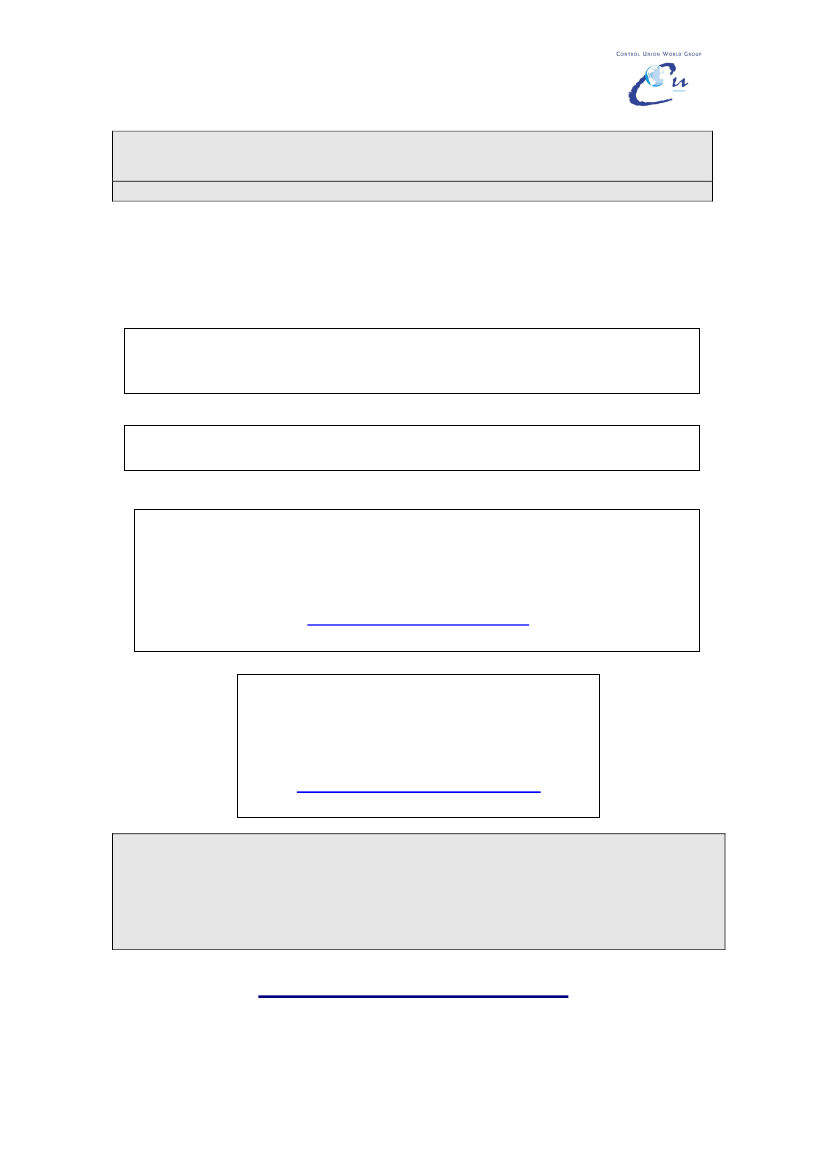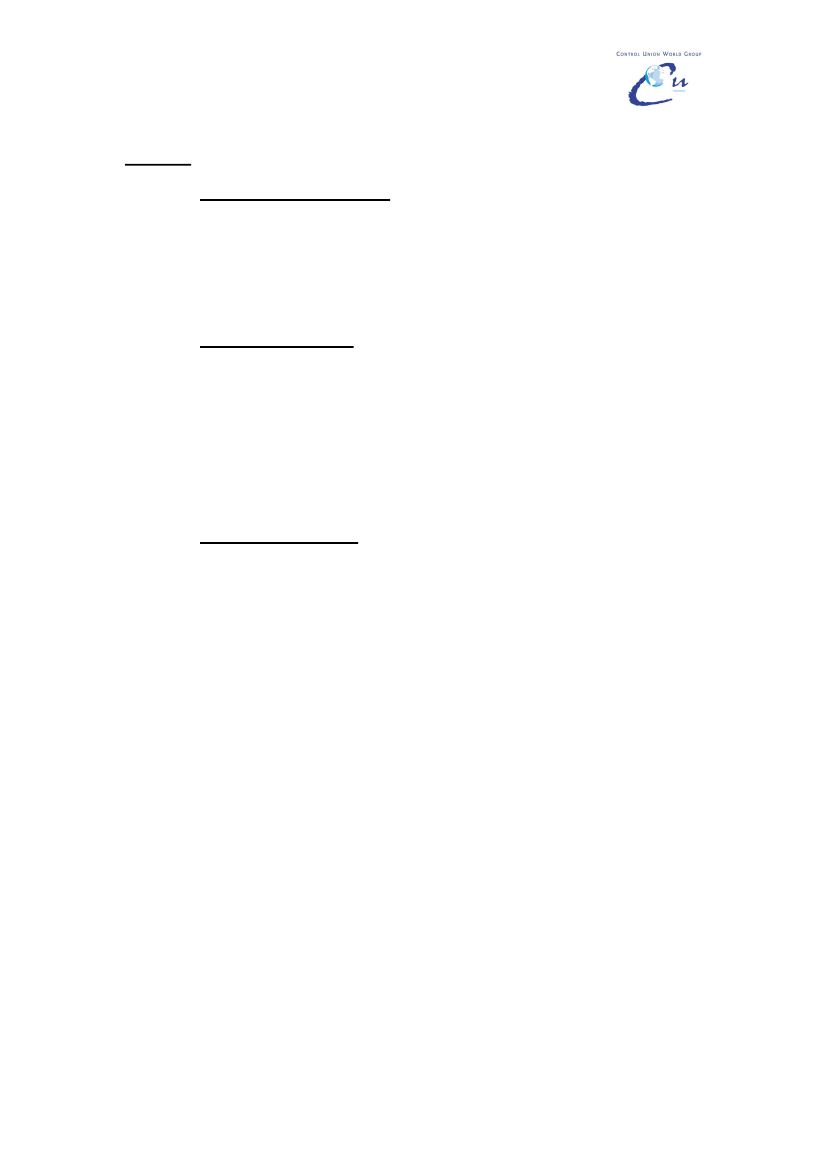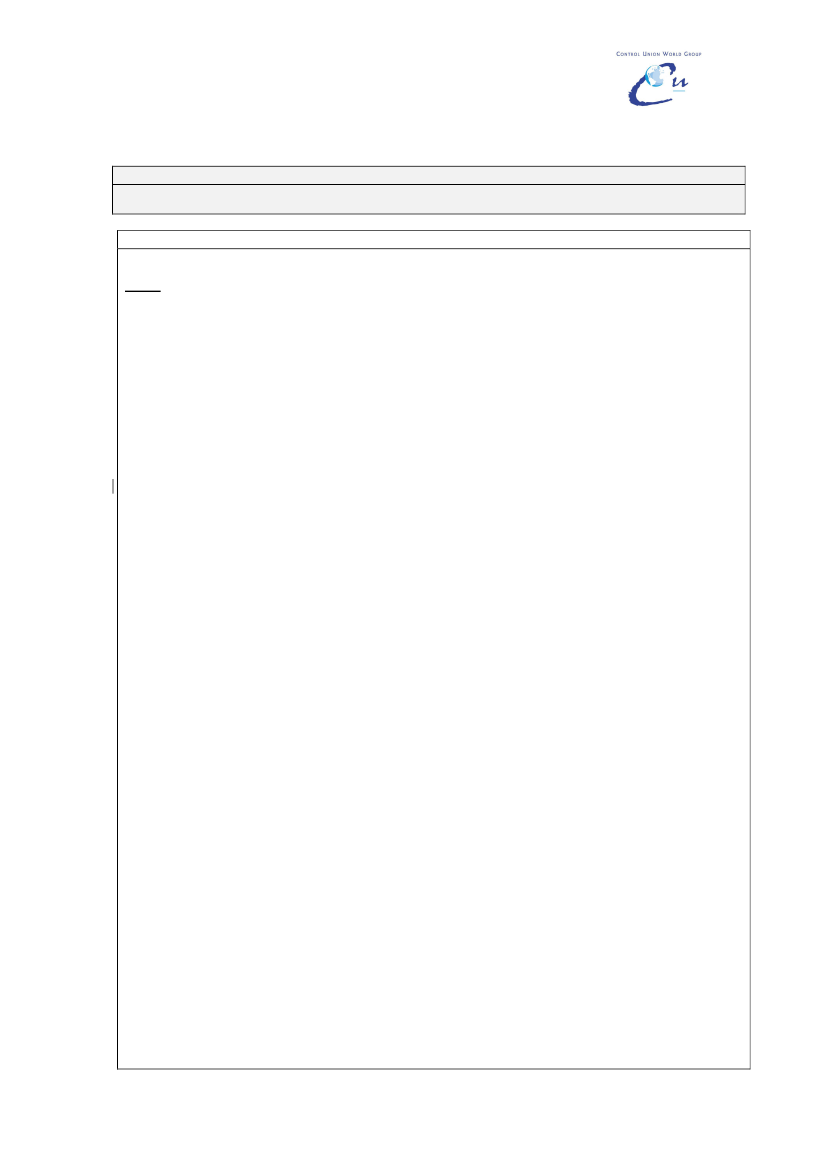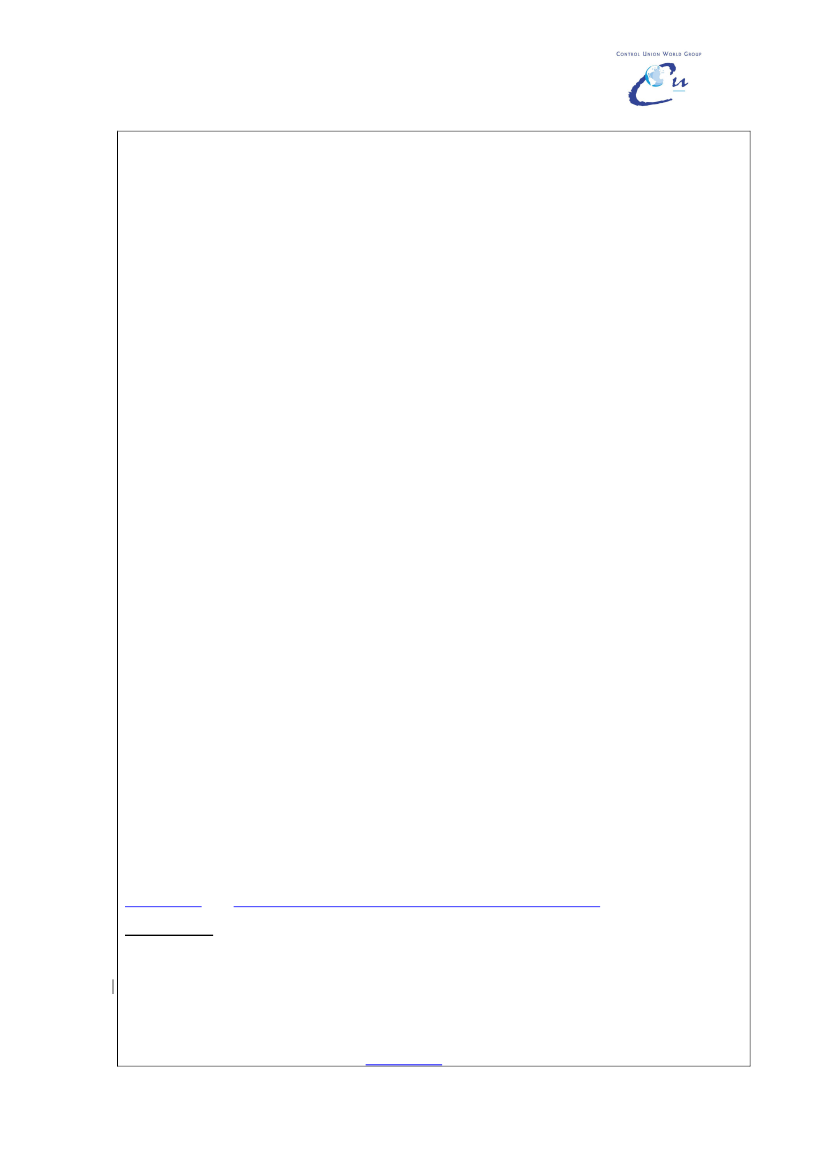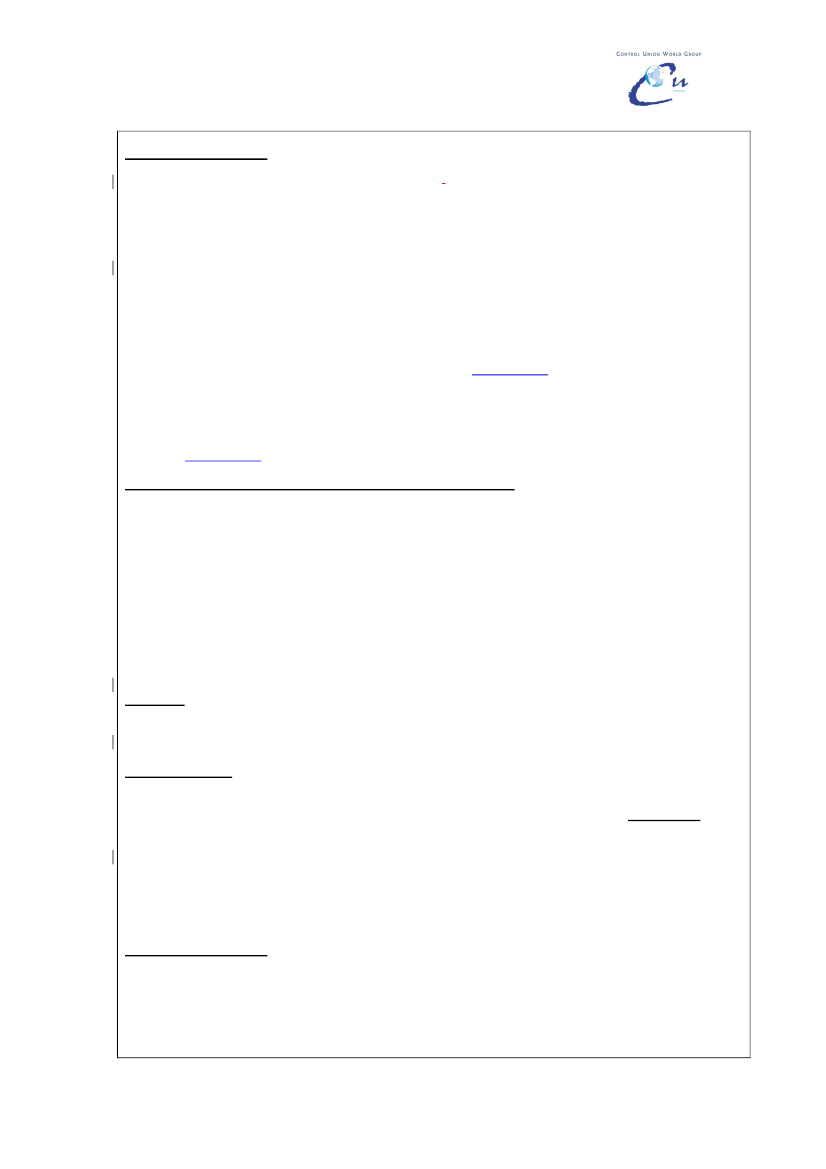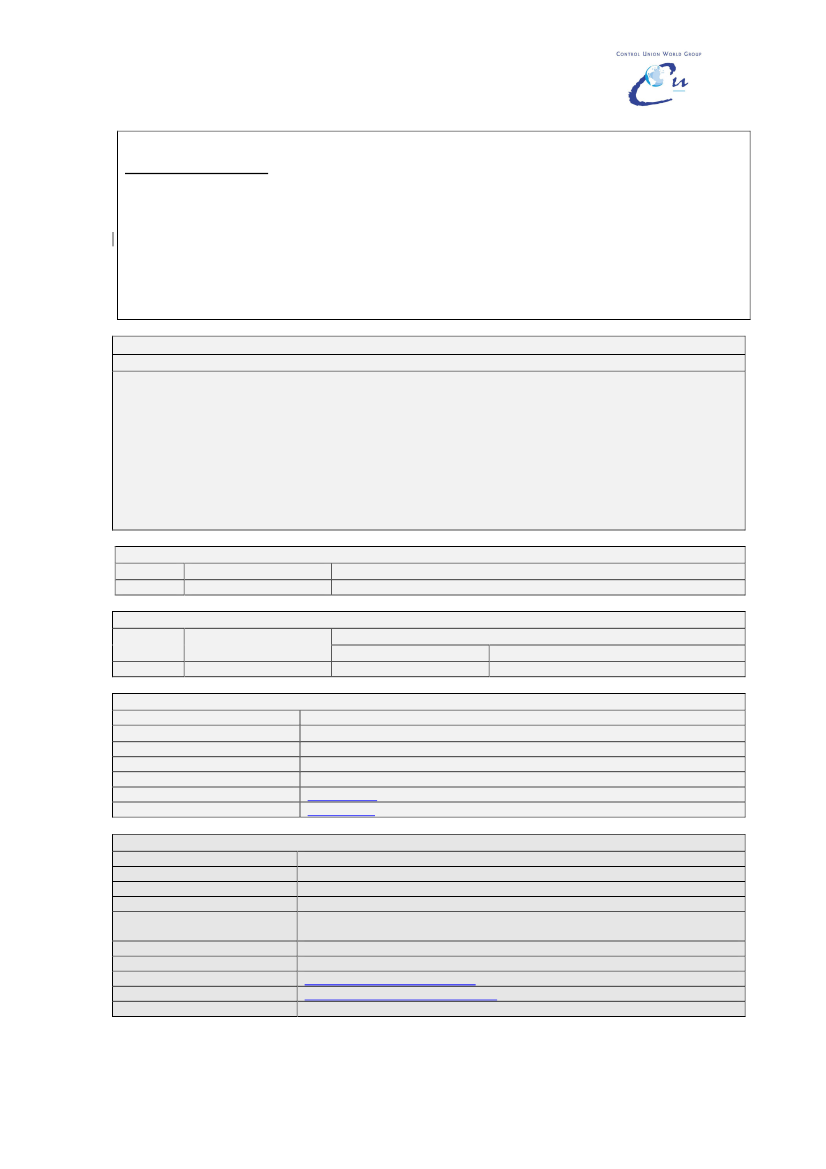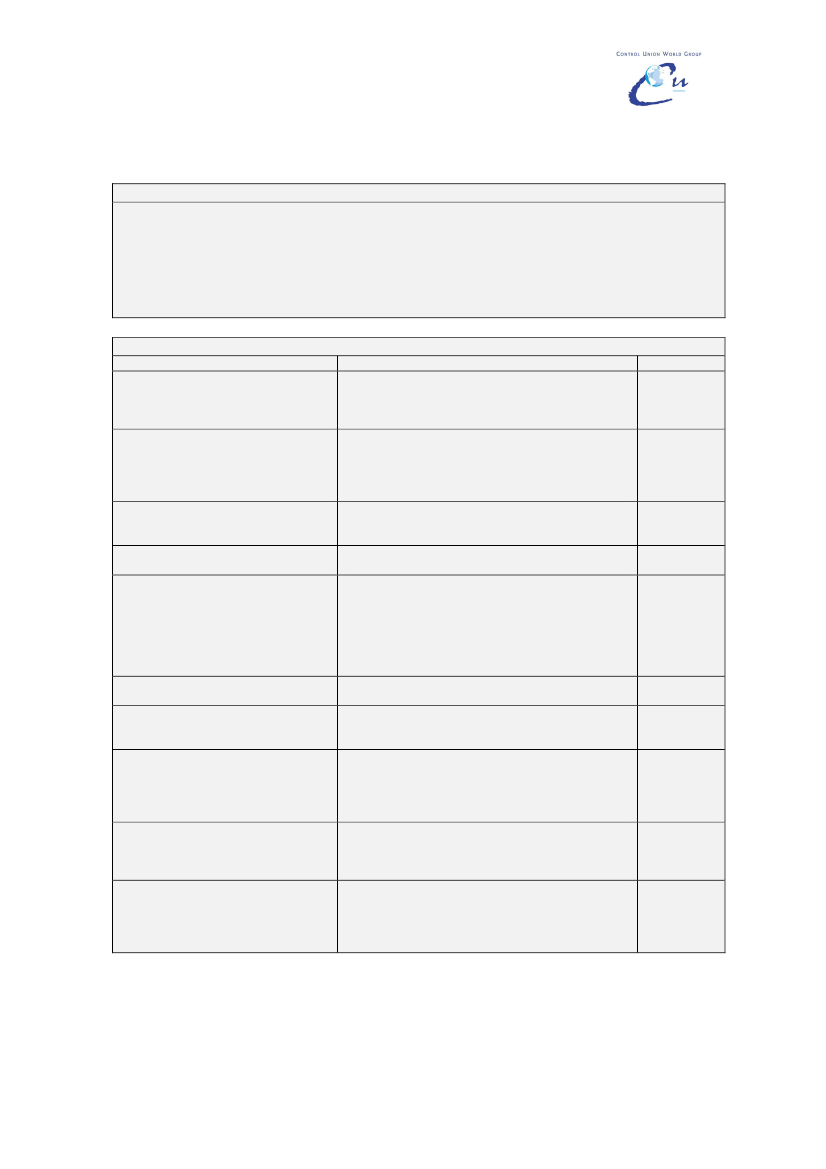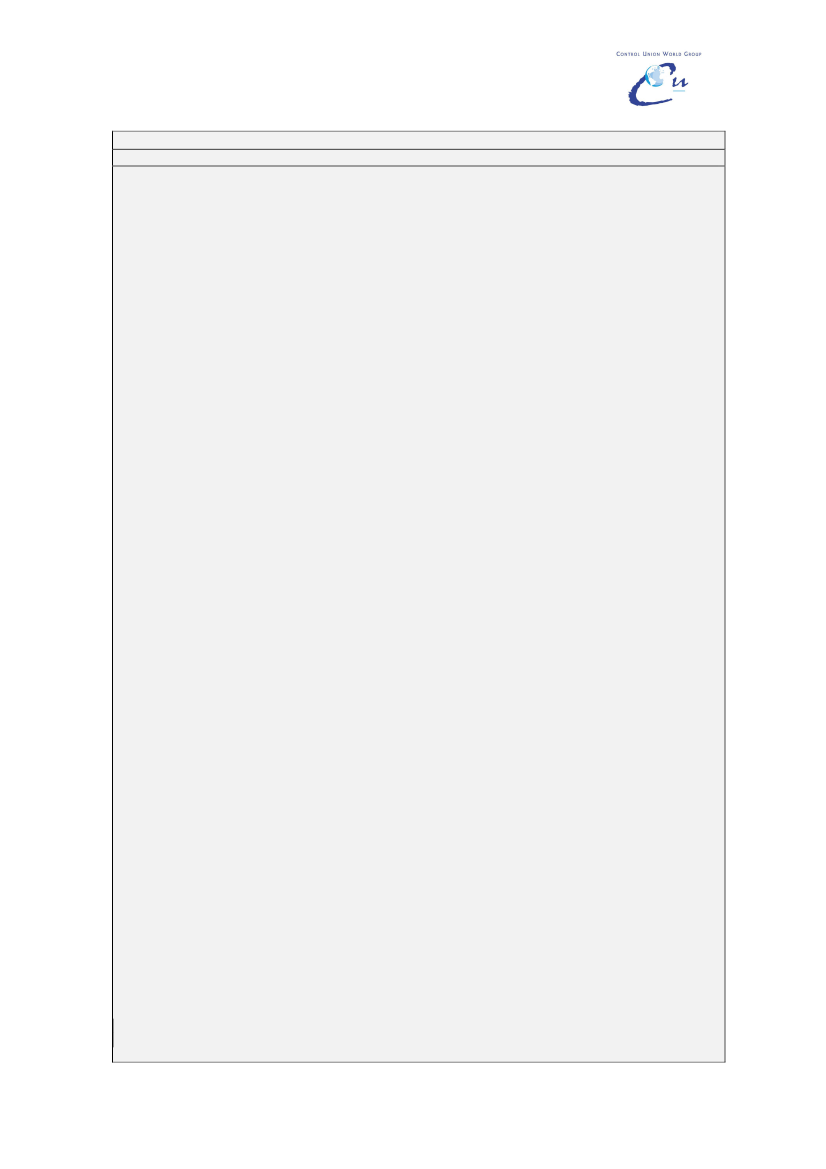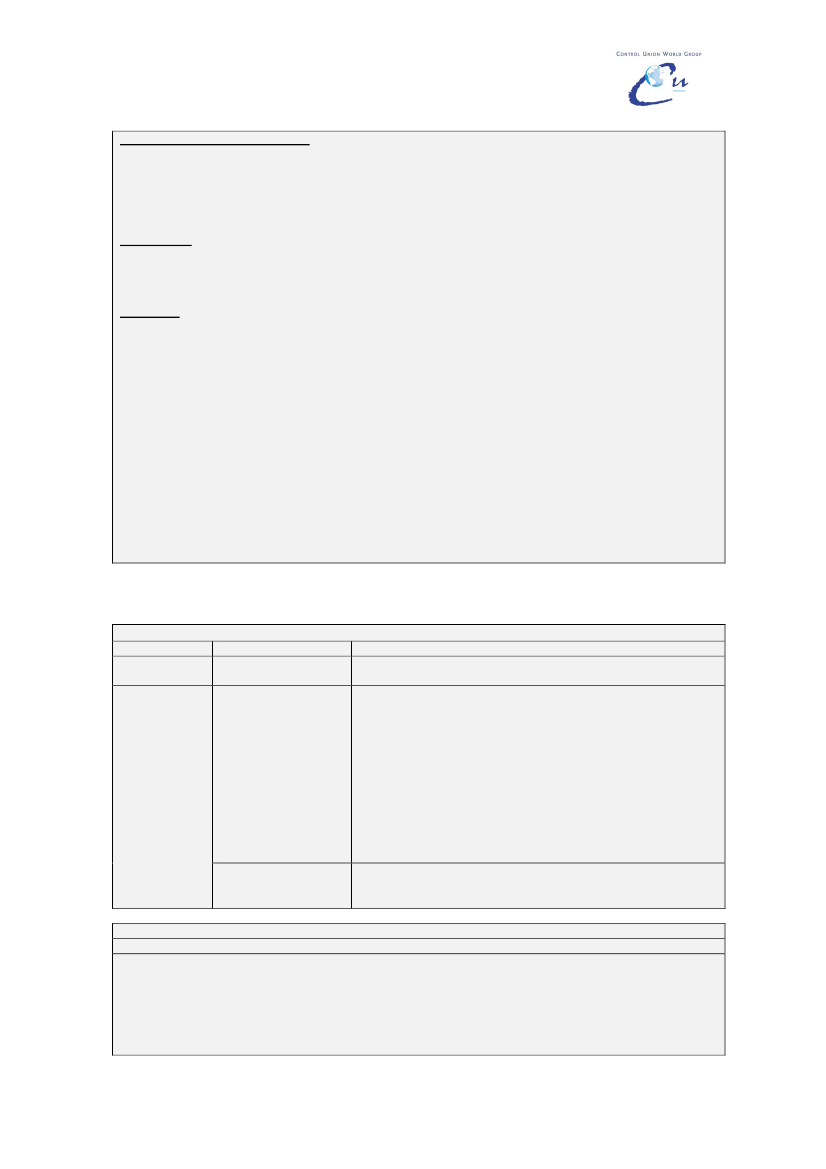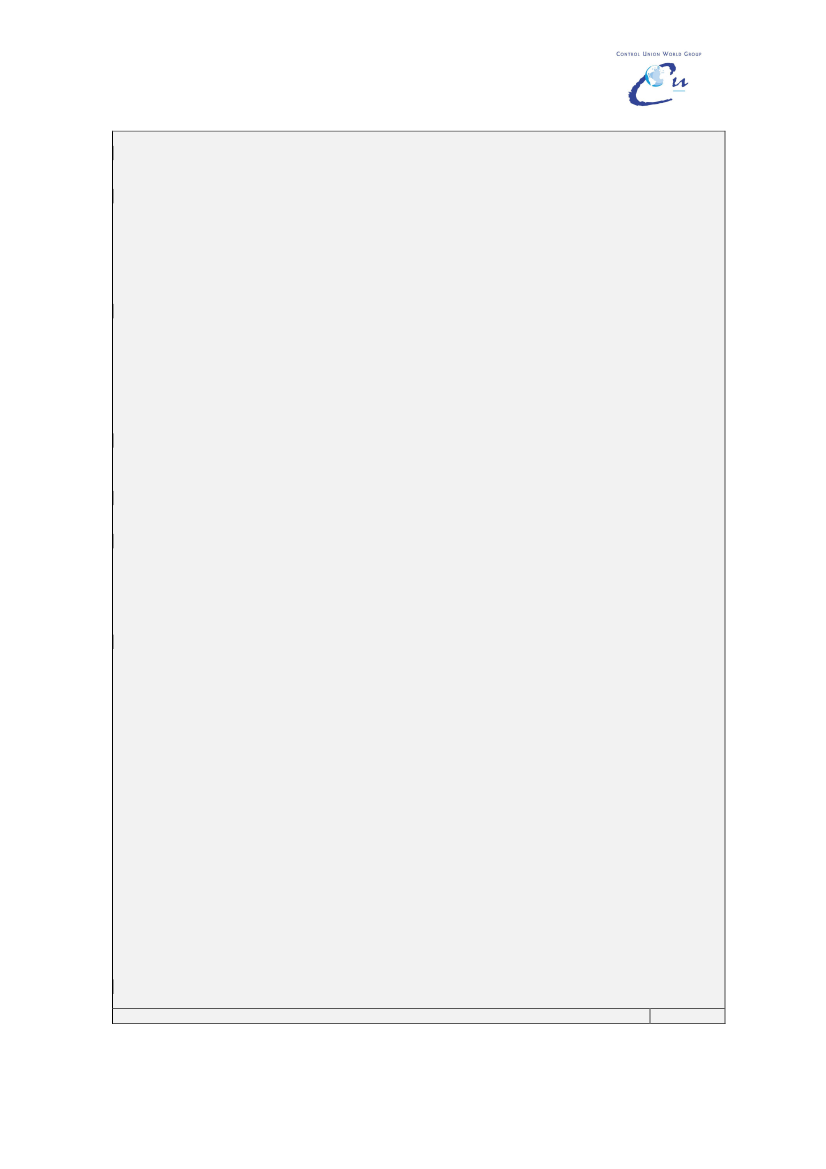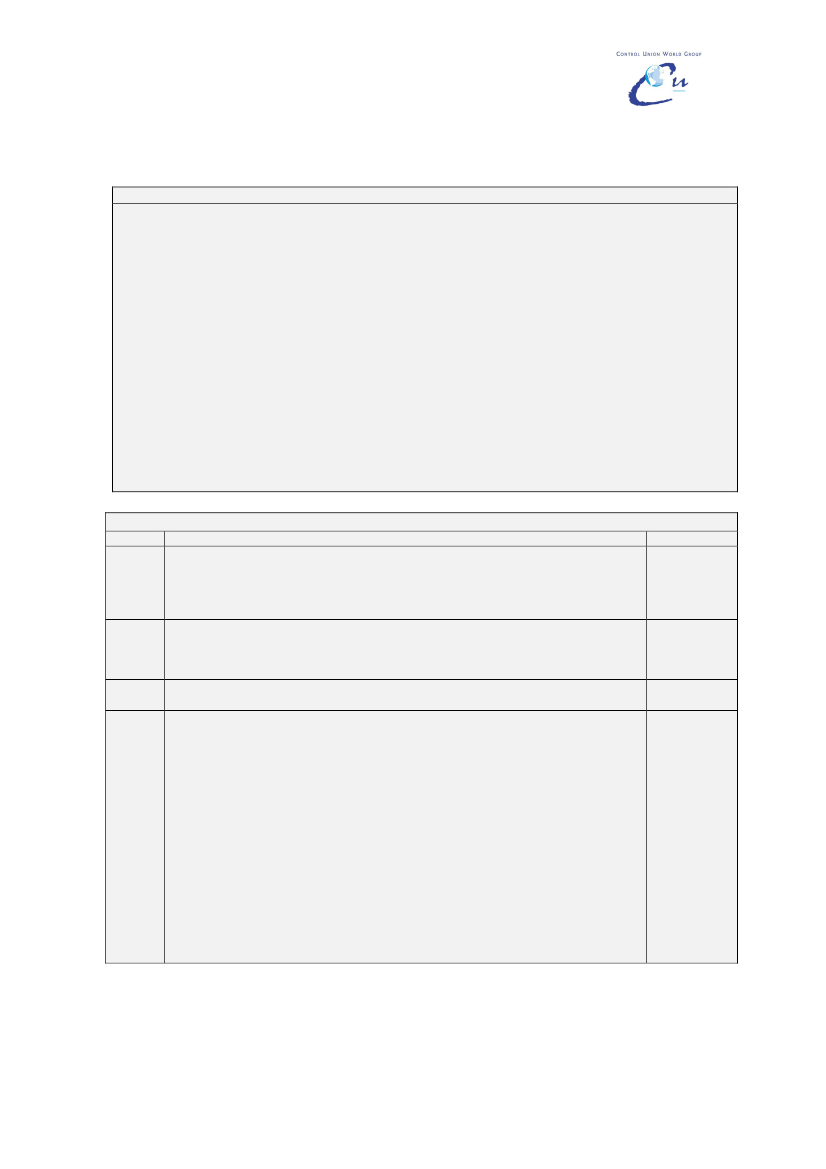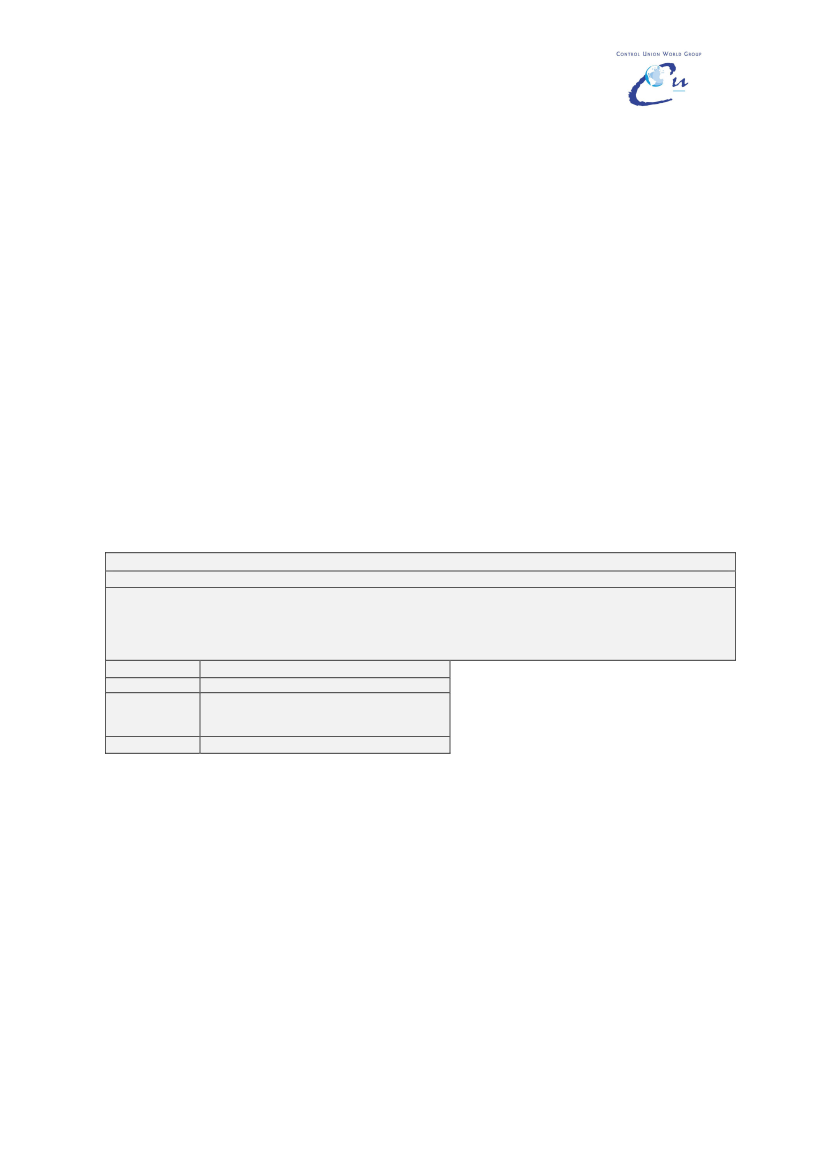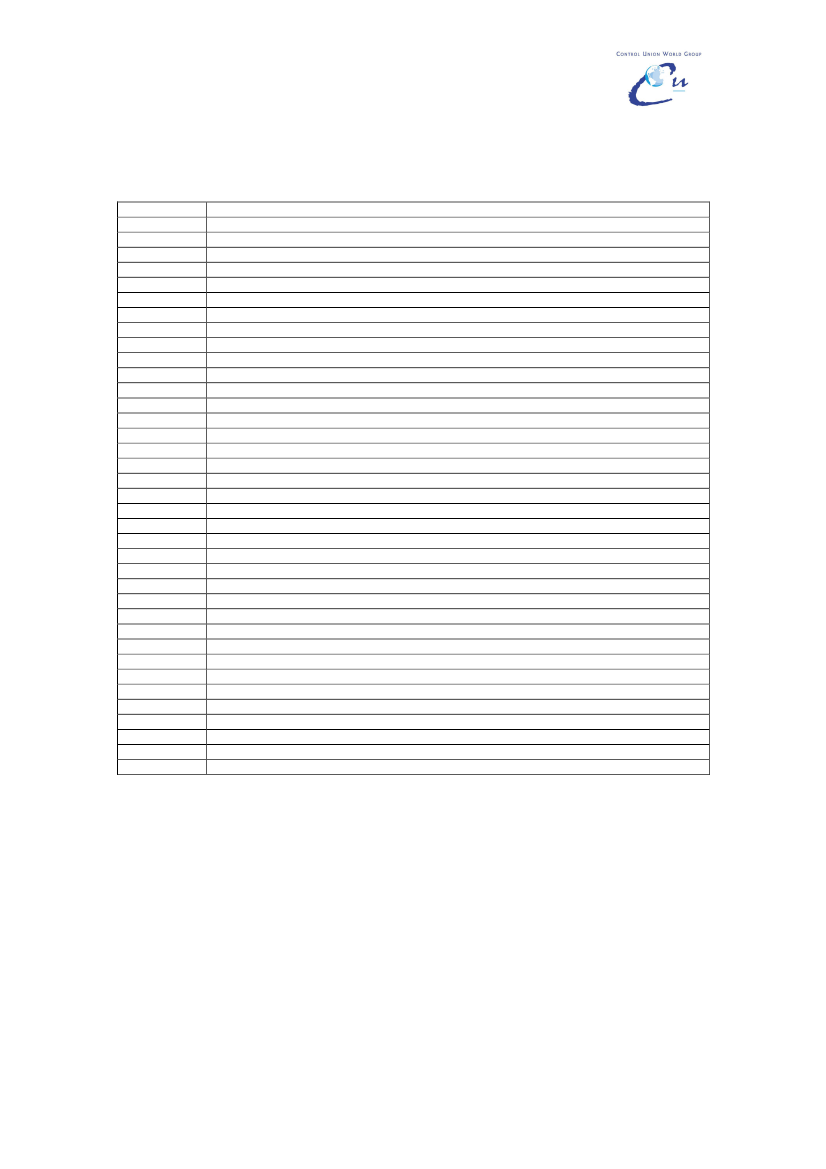Miljø- og Planlægningsudvalget 2010-11 (1. samling)
MPU Alm.del Bilag 96
Offentligt
Report number: CUCRPT – Danish Energy Agency
Gap Analysis ReportReport submitted to:Danish
Location: United Plantations BerhadThis report has been prepared in accordance with RSPO requirements forchemical handling and the information included is the result of a gap analysis ofthe estate as included in the scope of the assessment.
Report prepared by: A. Senniah.
Control Union (Malaysia) S/BPersiaran Raja Muda Musa,Off Jalan Sg Berith,Teluk Gadong, 41100, Klang, Selangor. Malaysia.Phone 03-3377 1600 / 1700
Control Union Certifications. (Head office)Meeuwenlaan 4-6,P.O. Box 161.8000 AD Zwolle.The Netherlands.Phone: 0031 38436 0100Control Union Certifications is a member of the Control Union World Group - an international inspection andcertification body. CU performs assessments and certification in many agricultural based fields such asFSC, RSPO P&C, RSPO SCCS, ISCC, Organic production, Sustainable Textile Production, OrganicExchange, Eurepgap, GlobalGAP, HACCP, BRC, GMP and GTP.CU is accredited by the Dutch Council of Accreditation (RVA) on the European quality standard EN 45011for the inspection and certification of CU Organic program (according to the EU regulation 2092/91) andEUREPGAP program. When requested a copy of the accreditation certificate can be obtained from CU.
Gap analysis report. Sept 2010.
Page 1 of 14
Report number: CUCRPT – Danish Energy AgencyContents1. Scope of the Assessment.1.11.21.3National Interpretation used for the assessment.Assessment type. (Estates).Description of the supply base (estates).1.3.1General Description.1.3.2Location of the estate.1.3.3Statistics of the estate.Contact person.
1.42.12.2
2. Assessment Process
2.3
2.4
3
3.13.23.3
Assessment Findings
Certification body.Qualifications of the assessor.2.2.1Qualifications of the assessorAssessment methodology.2.3.1General overview.2.3.2Assessment agenda including:•Assessment dates.•Sites visited.•Main activities.Stakeholder consultation.2.4.1Summary of how stakeholder consultation was organised.Assessor’s summary.Summary of the findings by criteria.Formal sign-off of the assessment findings.3.3.1Acknowledgment of internal responsibility by the client.
Gap analysis report. Sept 2010.
Page 2 of 14
Report number: CUCRPT – Danish Energy Agency
1.
SCOPE OF THE ASSESSMENT.1.1 National Interpretation used.
The management of the Palm Oil Estate which produce FFB were assessed for compliance against the RSPOcriteria as interpreted and endorsed for Malaysia.
Gap analysis of RSPO requirements for chemical handling at Jendarata estate owned by United PlantationsBhd.RSPOThe Roundtable on Sustainable Palm Oil (RSPO) is a global, multi-stakeholder initiative on sustainable palm oil.Members of RSPO and participants in its activities come from many different backgrounds, including plantationcompanies, manufacturers and retailers of palm oil products, environmental NGOs and social NGOs and frommany countries that produce or use palm oil. The principal objective of RSPO is “to promote the growth and useof sustainable palm oil through co-operation within the supply chain and open dialogue between itsstakeholders”. The RSPO Principles and Criteria for Sustainable Palm Oil Production were adopted inNovember 2005. National Woking Groups have now produced NI’s for Malaysia, Indonesia and Papua NewGuinea, and it is against the appropriate National Interpretation that an assessment is conducted.There are 8 principles, 39 Criteria and 125 indicators in the RSPO P&C standard which is used to evaluatewhether an oil palm plantation and palm oil mill is operating within the RSPO P&C standards. There are a totalof 65 major indicators and 60 minor indicators.Following are the major indicators:1.1.1 Records of requests and responses must be maintained.1.2.1 Land Titles/user rights1.2.2 Safety and health plan1.2.3 Plans and impact assessments relating to environmental and social impacts1.2.4 Pollution prevention plans1.2.5 Details of complaints or grievances1.2.6 Negotiation procedure1.2.7 Continuous improvement plans2.1.1 Evidence of compliance with relevant legal Indicators2.2.1 Evidence of legal ownership of the land including history of land tenure.2.2.2 Growers must show that they comply with the terms of the land title.2.3.1 Where lands are encumbered by customary rights, participatory mapping should be conducted toconstruct maps that show the extent of these rights.2.3.2 Map of appropriate scale showing extent of claims under dispute.3.1.1 Annual budget with a minimum 2 years of projection. Annual budget may include FFB yield/ha, OER, CPOyield/ha and cost of production that is not required to be publicly available.4.1.1 Documented Standard Operating Procedures (SOP) for estates and mills4.4.1 Protection of water courses and wetlands, including maintaining and restoring appropriate riparian bufferzones at or before replanting along all natural waterways within the estate. Riparian buffer zones:Reference to be made to relevant national regulations or guidelines from state authorities e.g. Departmentof Irrigation and Drainage (DID), whichever is more stringent.4.4.2 No construction of bunds/weirs/dams across the main rivers or waterways passing through an estate.4.4.3 Outgoing water into main natural waterways should be monitored at a frequency that reflects the estatesand mills current activities which may have negative impacts (Cross reference to 5.1 and 8.1).4.6.1 Written justification in Standard operating Procedures (SOP) of all agrochemicals use.4.6.2 Pesticides selected for use are those officially registered under the Pesticides Act 1974 (Act 149) and therelevant provision (Section 53A); and in accordance with USECHH Regulations (2000). Reference shallalso be made to CHRA (Chemical Health Risk Assessment)4.6.3 Pesticides shall be stored in accordance to the Occupational Safety and Health Act 1994 (Act 514) andRegulations and Orders and Pesticides Act 1974 (Act 149) and Regulations.4.6.4 All information regarding the chemicals and its usage, hazards, trade and generic names must beavailable in language understood by workers or explained carefully to them by a plantation managementofficial at operating unit level.4.6.5 Annual medical surveillance as per CHRA for plantation pesticide operators.4.6.6 No work with pesticides for confirmed pregnant and breast-feeding women.4.6.8 Documented justification of any aerial application of agrochemicals. No aerial spraying unless approvedby relevant authorities.4.7.1 Evidence of documented Occupational Safety Health (OSH) plan which is in compliance with OSH Act1994 and Factory and Machinery Act 1967(Act 139).4.7.2 Records should be kept of all accidents and periodically reviewed at quarterly intervals.
1.2 Assessment type.
Gap analysis report. Sept 2010.
Page 3 of 14
Report number: CUCRPT – Danish Energy Agency4.7.3 Workers should be covered by accident insurance.4.8.1 A training programme (appropriate to the scale of the organization) that includes regular assessment oftraining needs and documentation, including records of training for employees are kept.5.1.1 Documented aspects and impacts risk assessment that is periodically reviewed and updated.5.2.1 Identification and assessment of HCV habitats and protected areas within landholdings; and attemptassessments of HCV habitats and protected areas surrounding landholdings.5.2.2 Management plan for HCV habitats (including ERTs) and their conservation.5.3.1 Documented identification of all waste products and sources of pollution.5.5.1 No evidence of open burning. Where controlled burning occurs, it is as prescribed by the EnvironmentalQuality (Declared Activities) (Open Burning) Order 2003.5.6.1 Documented plans to mitigate all polluting activities (Cross ref to C5.1.)6.1.1 A documented social impact assessment including records of meetings.6.2.1 Documented consultation and communication procedures.6.3.1 Documentation of the process by which a dispute was resolved and the outcome. Records are to be keptfor 3 years.6.4.1 Establishment of a procedure for identifying legal and customary rights and a procedure for identifyingpeople entitled to compensation.6.5.1 Documentation of pay and conditions.6.6.1 Documented minute of meetings with main trade unions or workers representatives.6.7.1 Documentary evidence that minimum age Indicator is met.6.8.1 A publicly available equal opportunities policy.6.9.1 A policy on sexual harassment and violence and records of implementation.6.9.2 A specific grievance mechanism is established.6.10.1 Pricing mechanisms for FFB and inputs/services shall be documented.7.1.1 An independent and participatory social and environmental impact assessment (SEIA) to be conductedand documented7.2.1 Soil suitability maps or soil surveys adequate to establish the long-term suitability of land for oil palmcultivation should be available.7.3.1 An HCV assessment, including stakeholder consultation, is conducted prior to any conversion.7.3.2 No conversion of Environmentally Sensitive Areas (ESAs) to oil palm as per Peninsular Malaysia’sNational Physical Plan (NPP) and Sabah Forest Management Unit under the Sabah Forest ManagementLicense Agreement.7.3.3 No new plantings on floodplains (reference to be made to State DID).7.4.1 All new plantings should not be cultivated on land more than 300m above sea level and on land morethan 25 degrees slope unless specified by local legislation7.5.1 This activity should be integrated with the SEIA7.6.1 Documented identification and assessment of legal and customary rights.7.6.2 Establishment of a system for identifying people entitled to compensation.7.6.3 This activity should be integrated with the SEIA required by C 7.17.6.4 Establishment of a system for calculating and distributing fair compensation (monetary or otherwise).7.6.5 The process and outcome of any compensation claims should be documented and made publiclyavailable.7.7.1 No evidence of clearing by burning. This activity should be integrated with the SEIA required by C 7.1.7.7.2 Evidence of approval for controlled burning, as per Environmental Quality. (Declared Activities) (OpenBurning) Order 2003.8.1.1 Demonstrate progressive improvement in Minimise use of certain pesticides8.1.2 Demonstrate progressive improvement in Environmental impacts8.1.3 Demonstrate progressive improvement in Maximizing recycling and minimizing waste or by-productsgeneration. To work toward zero-waste8.1.4 Demonstrate progressive improvement in Pollution prevention plans8.1.5 Demonstrate progressive improvement in Social impactsThe full list of the RSPO P&C standard and details of the major and minor indicators can be found atwww.rspo.orgor athttp://www.rspo.org/sites/default/files/Malaysia-NI%28final%29.pdfThe certificate.The RSPO certificate is awarded to the company. The mills and suppliers are included in the assessment.All the FFB from the directly managed lands (or estates) shall be produced to certifiable standards. Thecompany will develop and implement a plan to ensure that 100% of associated smallholders and out-growersare of certifiable standard within 3 years.United Plantations Berhad was awarded RSPO P&C certificate on 21 August 2008. The certificate is valid forfive years. There will be annual surveillance assessment throughout the certification validity period. During themain assessment and subsequent annual surveillance assessment there was no any major non conformance.The full assessment report can be found atwww.rspo.orgst
Gap analysis report. Sept 2010.
Page 4 of 14
Report number: CUCRPT – Danish Energy AgencyWhat is an RSPO audit?It is a systematic, independent and documented process for obtaining audit evidence and evaluating itobjectively to determine the extent to which principle and criteria are fulfilled.Auditors are seeking evidence as to how the management systemscomplywith the principles and criteria andthat those management systems are beingimplemented.An audit must be a positive experience for the auditee. The auditors have no pre-conceived expectations as tohow the auditee must prepare their management systems to conform to the standard. It is the role of the Auditorto identify; not only how the management systems comply with the standard but also how those managementsystems are implemented.An audit with RSPO P&C standard at United Plantation was first conducted in May 2008. There were 5 auditorsinvolved in the assessment, going through all the 8 Principles and 125 indicators listed in the RSPO P&Cstandard. During the main audit at United Plantations Berhad there were five auditors involved and they spent atotal of 21 man days on site. There were stakeholder meeting conducted on site and attended by stakeholderswho are interested in the assessment. The full assessment report, auditors’ details, audit findings andstakeholders’ comments can be found in the RSPO website atwww.rspo.orgOnce the company is certified, the certificate is valid for five years and there will be an annual surveillanceassessment to ensure that the management system and RSPO P&C is continuously implemented. During thelast annual assessment, it is found that United Plantation is continuously complying with RSPO P&C. The fullassessment report, auditors’ details, audit findings and stakeholders’ comments can be found in the RSPOwebsite atwww.rspo.orgRSPO Document review and interview with workers/stakeholders.Unrestricted access to all management documents is given by the estates to the auditors to verify that themanagement systems comply with the RSPO P&C’s. During the assessment, auditor will interview staff,workers and stakeholders to verify that the management systems are being implemented. Interview isconducted without the present of managers and management representatives. This is to allow the workers andstakeholders to give their feedback without any interruption by management representatives. Workers areasked about Training, H&S, Medical facility, check-up and treatment, work contracts, wages, child labourissues, housing and recreational facility, harassment policies, grievance and dispute settlement procedures,prompt payments and contribution by company towards community development. Female workers areinterviewed in private to ensure that they can share any gender issues. Photographs are taken, if necessary,with the permission from the management. Workers and stakeholders are made aware of the assessment andduring the first main assessment, there will be stakeholder meeting attended by internal and externalstakeholders including NGOs, government representatives and regulatory bodies.Are they aware that an audit is being conducted?Sampling.Assessments are conducted at a moment in time. Auditors are assess a sample of the properties owned by thecompany, at a moment in time. It may be that at the time of the surveillance assessment, the audit team mightfind non-compliance where compliance found during the first assessment.Non-conformities.There are 8 principles in RSPO P&C covering people, planet and profit. It is divided into major and minorindicators.For any action there is an equal and opposite reaction! In auditing process, assessors seekcomplianceandpositive evidence but in so doing there is a possibility that assessor find non-compliance! Non compliance isinformed to the management representatives in advance when assessor suspects that non-conformity may beraised at the closing meeting. Assessor will also highlight good practice as the audit progresses.During the assessment the management is told not to attempt to put into place an amended managementsystem that they think will eliminate the need for the assessors to raise that particular non-conformity beforethe closing meeting. It may not be possible to write and grade observations until the end of the audit.Major non-conformities.It is not possible for the audit team to make a recommendation for certification of there is even a singlemajor non-compliance raised during a main assessment.Auditor would agree a time frame with the management to close out that Major NC and the lead auditormayhave to return to carry out an on site evaluation – depending upon the nature and number of NC’s.(A major NC raised during a surveillance visit must be closed out within 60 days. Failure to do so will result insuspension of the certificate; followed three months later by withdrawal of the certificate if still open. A new main
Gap analysis report. Sept 2010.
Page 5 of 14
Report number: CUCRPT – Danish Energy Agencyassessment will then be necessary to re-instate the certificate).Minor non-conformities.If there are consistent failures within a single principle, then the audit team may raise a major non-conformity covering that whole principle.Minor non-conformities are usually closed out at the first surveillance visit. Failure to do so will result in the NCbeing elevated to a Major NC and three months given to close it out as above.Auditors will be seeking evidence of compliance with the standard and at no time are they trying to catch outthe auditee with their questions. During the audit they will raise issues that they consider will result in non-conformities to be presented at the closing meeting. They will be reviewing the effectiveness andimplementation of your management systems and how they comply with the standard.
1.3 Description of the estate.During this assessment, Jendarata estate own by United Plantations Bhd. were visited and assessed againstRSPO requirement for chemical handling.The estate is managed by a Senior Estate Manager and assisted by a number of assistant managers. Thisestate is fully planted with oil palm. Daily operations are arranged in the morning and safety briefing is given tothe workers by the assistant managers. All the operational groups or gang in supervised by a full timesupervisor called “mandor”.All the facilities for the workers such as housing, clinic, crèche, kindergarden, school, community hall, shop andother recreational facilities located within the estate. There is a town nearby the estate which is accessible tothe workers. Majority of the workers have their own transport such car, motorcycle and bicycle. They arestaying at the three room houses provided by the estate.
1.3.1 General description.
1.3.2 Location of the estates.CU CodePO1
Name of the estateJendarata Estate
Location address.36009 Teluk Intan,Perak, Malaysia
1.3.3 Statistics of the supply base.CU CodePO1Name of the estateJendarata Estate
Immature5682.10
Area of oil palm (ha)Mature341.90
1.4 Contact person. (Danish Energy Agency)Principle Contact person:Business address:Office telephone:Mobile telephone:Fax:e-mail:Web site:
Ole Emmik Sorensen44, Amaliegade, DK – 1256 Copenhagen K.+45 33 92 67 00+45 25 37 56 76+45 33 11 47 43[email protected]www.ens.dk
1.5.3 Details of the assessmentName of Client:Date of the assessmentDate of the closing meetingAssessment byAddress
TelephoneFaxEmailWebsiteLead Auditor (contact person)
Danish Energy Agencyth28 September 2010th28 September 2010Control Union Certifications (Malaysia Office)Control Union (Malaysia) S/B,Persiaran Raja Muda Musa, Off Jalan SgBerith, Teluk Gadong, 41100, Klang, Selangor. Malaysia.+603 3377 1600+603 3377 1800[email protected]www.controlunion.com/certificationA. Senniah
Gap analysis report. Sept 2010.
Page 6 of 14
Report number: CUCRPT – Danish Energy Agency
2.
ASSESSMENT PROCESS.2.1 Certification Body.
Control Union Certifications is a member of the Control Union World Group - an international inspection andcertification body. CU performs assessments and certification in many agricultural based fields such asFSC, RSPO, and Organic production, Sustainable Textile Production, Organic Exchange, Eurepgap,HACCP, BRC, GMP and GTP.CU is accredited by the Dutch Council of Accreditation (RVA) on the European quality standard EN 45011for the inspection and certification of CU Organic program (according to the EU regulation 2092/91) andEUREPGAP program. When requested a copy of the accreditation certificate can be obtained from CU.
RSPO REQUIREMENTA minimum of post high school (postsecondary school) training in eitheragriculture/forestry, environmentalscience or social sciences;At least 5 years professionalexperience in area of work relevant tothe assessment (e.g., palm oilmanagement; agriculture/forestry;ecology; social science);Training in the practical application ofthe RSPO criteria, and RSPOcertification systems;Successfully completion of an ISO9000:19011 lead assessors course;A supervised period of training inpractical assessmenting against theRSPO criteria or similar sustainabilitystandards, with a minimum of 15 daysassessment experience and at least 3assessments at differentorganisations.Fluent in main local languages andEnglish.Good agricultural practices (GAP),integrated pest management (IPM),pesticide and fertilizer use.Health and Safety assessmenting onthe farm and in processing facilities.(For example OHSAS 18001 oroccupational. Health and SafetyAssurance System).Workers welfare issues and socialassessmenting experience. (Forexample with SA8000 or relatedsocial or ethical accountability codes).Environmental and ecologicalassessmenting. (For exampleexperience with organic agriculture,ISO 14001 or environmentalmanagement systems).
2.2 Qualifications of the assessor.
QUALIFICATIONSPost graduate qualification in human resourcemanagement with more than 10 years workingexperience in plantation.More than 10 years working experience inplantation. Involved in RSPO auditing since April2009. Fully trained in similar agriculture certificationprogrammes such as RSPO P&C, RSPO SCCS,Global Gap, ISCC and GMP.Involved in RSPO assessment since April 2009.Member of CUC RSPO audit team. Involved inaudits conducted in Malaysia and Indonesia.Completed ISO 9001:2008 lead auditor course inSeptember 2009.Member of CUC RSPO audit team since April2009. Involved in audits conducted in Malaysia andIndonesia since April 2009 in 8 different companiesin Malaysia and Indonesia.
ComplianceYes
Yes
YesYesYes
Able to speak and fluent English, Bahasa Malaysia,Tamil and local dialects.More than 10 years working experience in Palm Oilplantation.Working experience in palm oil plantation. Involvedin RSPO audits since April 2009. Team member inother certification standards such as Globalgap andGMP.Working experience in palm oil plantation. Involvedin RSPO audits since April 2009. Team member inother certification standards such as Globalgap andGMP.Working experience in palm oil plantation. Involvedin RSPO audits since April 2009. Team member inother certification standards such as Globalgap andGMP.
YesYesYes
Yes
Yes
Gap analysis report. Sept 2010.
Page 7 of 14
Report number: CUCRPT – Danish Energy Agency2.3 Assessment methodology.Sustainable palm oil production is comprised of legal, economically viable, environmentally appropriate andsocially beneficial management and operations. This is delivered through the application of the principlesand criteria, and the accompanying guidance. This report focusing on indicators and guidance for chemicalhandling. Indicators are specific pieces of objective evidence that must be in place to demonstrate or verifythat the criterion is being met.The assessment was carried out in conformity with the procedures as laid down in the CUC RSPOProcedure Manual and the program manual for the assessor and certifier. During the assessment thequalified CUC assessors used the RSPO standard as endorsed for the country in which the assessmenttook place and recorded their findings. This assessment is focusing only on issues related to chemicalhandling at Jendarata Estate. Jendarata estate was assessed throughout this exercise.The assessment team includes one CUC assessor, three members representing Danish Energy Agency,one representative from Danish Ministry of the Environment and one representative from Danish EnergyManagement.The opening meetings held at Unitata meeting room and subsequently the assessment team went toJendarata estate. The assessment team visited the Jendarata Field office where all the RSPO documentsrelated to herbicide and pesticide handling were shown and briefed by the Senior Manager. A total of 28files were sited includes safety training programme, safe working procedure, chemical handling procedure,annual medical surveillance records of the pesticide and herbicide applicators, IPM records (census,beneficial plant records), pesticide register, permit from local regulatory bodies, inspection records by thegovernment Department Of Safety and Health (DOSH), list of chemical applicators, PPE issuance andimplementation and monitoring records, and other records related to safety and health.Once the document inspection and verification is completed, the assessment team conducted field visit.During the field visit, herbicide spraying area visited. Male applicators were seen wearing complete PPEand supervised by fulltime supervisor. He was interviewed and he able to explain the emergency procedureand was carrying a first aid kit as per RSPO requirement which require first aid and first aider to be availableat work site. He further explained that applicators are given break time and there is clean water supply andsoap available on site to clean their hand and face.Subsequently other operations visited were bagworm census exercise by female workers. Demonstrationon how trunk injection is carried out and safety precautions taken, IPM establishment such as barn owlestablishment, tunera and other beneficial plants establishment, pheromone traps and harvesting operation.During the visit to the harvesting area, female Indian workers were seen collecting loose fruits. Interviewwith them revealed that they are aware of safe working procedures.Stakeholder consultation held during the assessment through meeting and interview with members ofNational Union of Plantation Workers (United Plantations Branch) and field workers. All the workers unionmembers, the Perak state secretary and Chairman who attended this consultation confirmed that safetyaspects during work is strictly enforced at Jendarata estate and United Plantations which includes PPE useand safe working procedure. They also stressed that there are no any herbicide or pesticide or any kind ofpoisoning has taken place in Jendarata estate or in UP. They highlighted that they are very unhappy withthe report in media about pesticide poisoning incidents because there are no such incident in their workplace.Closing meeting held to share the assessment findings between the management of United PlantationsBerhad, Jendarata Estate Manager and the assessment team.Following the opening meeting the audit team conducted a field inspection of the estate which include:•Chemical stores.Storage. MSDS leaflets. Herbicide mixing areas. PPE. Ventilation. Safe workingenvironment Security.•Field inspections.Herbicide application. Harvesting sites. P&D Census operation. SOP’s. Groundcover. IPM. First aiders and boxes. Other field observations of operations.•Worker interviews.OSH. First aid. Safety Awareness. Safe operating procedure.•Facilities.Housing area and other facilities.•Documentation review.Set of documents relates to RSPO P&C which focusing on chemical handlingwere sited and inspected at Jendarata estate.
2.3.1 General overview.
Gap analysis report. Sept 2010.
Page 8 of 14
Report number: CUCRPT – Danish Energy AgencyDocument review for the estate:We considered each and every applicable RSPO principle and criteria for the estate specially focusing onchemical handling. The estate executive was asked to ensure that all documents, procedures, maps andrecords referred to in the standard are available. The estate Senior Estate Manager then briefed theassessment team on the details of the documents. The list below is a summary of the records andmanagement plans, policies and records related to chemical handling inspected during the assessment.Verification.Verification of implementation was done through field observations (application of chemicals, PPEimplementation, safe operating procedures etc), chemical store inspections, chemical mixing areainspection, interview with workers and meeting with National Union of Plantation Workers (NUPW).Sampling.The assessment was conducted through a sampling of the area and documents available onsite. The auditteam sought compliance by filed audits and by reviewing the following site specific information and records.(Documents related to Palm Oil Mill not sampled)2.1 Evidence of compliance with relevant legal indicators. ( for OSH matters to comply with DOSHregulation and requirements and monitored periodically by DOSH)4.5 IPM plans. (The estate must implement IPM such as planting beneficial plants, pest incidentcensus, rat census, barn owl implementation)4.5 Pesticide toxicity records. (the active ingredients records)4.6 Pesticide and herbicide records. (field records where pesticide and herbicides are used)4.6 Disposal of agrochemical waste materials. (waste materials are disposed responsibly throughauthorised waste collector)4.7 OSH plans. (Plans includes safety policy, training, medical surveillance, first aid kit at work site)4.7 Accident records. (As per local regulation, reports to be submitted to DOSH)4.7 OSH training records.4.8 Training Plans.8.0 Commitment to continual improvement in key areas. (Principle 8 of RSPO P&C requires eachoperating units to develop a plan to continuously improve their best practices.
Date27th Sept201028th Sept2010
2.3.2 Assessment agenda.
Location /main sitesPerakUnited Plantations
•Travelling to Perak.
Main activities
Opening Meeting, Introduction by assessment team andUnited Plantations.Estate Assessment:•Chemical stores.Storage. MSDS leaflets. Herbicide mixingareas. PPE. Ventilation. Security.•Field inspections.Herbicide application programmes. Safeworking environment. Harvesting sites. SOP’s. IPM. Firstaiders and boxes. Field observations of operations.•Worker interviews.OSH. First aid. Awareness.•Facilities.Visit to housing area.•Document inspection and assessment.•Closing meeting.•Assessment team shared their findings and views.Questions and answers.
United Plantations
2.4 Stakeholder consultation and interview.2.4.1 Summary of how the stakeholder consultation was conducted.Stakeholders mainly comprised by field workers, workers union representatives and Perak State Chairmanand Secretary. The following questions were asked and their feedback recorded. The meeting wasconducted in the local Tamil and Bahasa Malaysia language to ensure that they understand the purpose ofthe consultation and to allow them to express their feedback freely. All the UP management representativewas asked to leave the meeting room and the consultation were conducted without their present as perRSPO requirement. This is to ensure that the workers comfortable and free to give their comments.
Gap analysis report. Sept 2010.
Page 9 of 14
Report number: CUCRPT – Danish Energy Agency1. Do you have any remarks on the safe handling of chemicals in Jendarata estate?Answer: Chemicals are handled safely with the enforcement of PPE and safe working environment.2. What is your relation with the plantation being assessed?Answer: Worker’s union members, secretary and chairman.3. Are there any plantation management practices that affect you and your health?Answer: No because we are given full and complete protective equipments for all kind of operations whichapproved by the DOSH. Medical surveillance conducted by doctor. Medical facility available at site. Thereare no issues.4. Do you consider any management is in conflict with the safe working environment?Answer: No5. Do you have any suggestions for management?Answer: Even before RSPO introduced, UP were having all the good practices. Our welfare and familywelfare is well taken care. That is why you can see some of us has been working here for more than 10years.6. Are you aware of any accidents related to chemical poisoning?Answer: No. If there is any we are the first one to confront the company. But we are confused and upsetwhy there are reports that such case has happened here although there are no such incident.7. Are you aware of any cases where PPE is not implemented?Answer: No. The fulltime supervisor and executive always monitor the PPE usage in the field and PPE isgiven free.8. Are there any adverse effects on workers due to poor working condition in estate?Answer: In Jendarata and in all the UP estates welfare and working condition are very well taken care.9. Additional comments.Answer: We as the Worker’s Union Representative would like to request any interested party to interviewdirectly with us if they want to know about our working environment here.11. Do you have any comments that you would like to discuss in private with the assessment team andwould you like to meet with them in future?12. Do you have any comments of the management’s any other plantations that you are aware?Answer: Generally in Malaysia, safety of workers is given high priority. There is enforcement by governmentdepartment.All the worker’s union members, the Perak state secretary and Chairman who attended this consultationconfirmed that safety aspects during work is strictly enforced at Jendarata estate and United Plantationswhich includes PPE use and safe working procedure. They also stressed that there are no any herbicide orpesticide or any kind of poisoning has taken place in Jendarata estate or in UP. They highlighted that theyare very unhappy with the report in media about pesticide poisoning incidents because there are no suchincident in their work place.The above stakeholder consultation was attended by women representative who are member of thedivisional and Jendarata estate Gender/Women Committee. To comply with RSPO P&C major indicators6.9.1 (A policy on sexual harassment and violence and records of implementation) and 6.9.2 (A specificgrievance mechanism is established), each operating units have their own Gender/Women committee toaddress women issues such as training for women, create awareness about women’s rights, counselling forwomen affected by any violence and to plan activities for women employees. The divisional committeereports to main estate committee which subsequently reports to main United Plantations Berhad’scommittee. It is important to stress that this Gender/Women committee is participated by women employeesfrom the field workers, general workers and office women employees and staff. They are given theopportunity and freedom to raise any issue related to women and they are reporting to the chairwomen ofmain committee. During the above consultation, the Gender/Women committee representatives confirmedthat they are treated equally and fairly by the management.Number of persons attended/interviewed:20
Gap analysis report. Sept 2010.
Page 10 of 14
Report number: CUCRPT – Danish Energy Agency
3.
ASSESSMENT FINDINGS.3.1 Assessor’s summary of the findings:
During the assessment, it is noted that the management of Jendarata is continuously implementing the RSPOP&C requirement specifically on issues related to pesticide and herbicide handling. Elimination of paraquatfrom their field operation was one of the major continuous improvements under principle 8.The management with the assistance from the Research Centre continuously conducting trials to findalternate for monocrothopos. At the moment IPM is being stressed to partially assist in controlling thebagworm incidents. Planting of beneficial plants such as tunera, cassia, antignon and carambola isimplemented extensively to attract predator insects which can control and eliminate bagworm. Monthly censusand aerial census were carried out to detect any leaf eating pest incidents. Barn owl is implemented at thedensity of one box per 20hactare to assist in rat control. This helps in reducing and eliminating rat baiting.During the visit to the pesticide and herbicide storage, it is noted that all the safety measures are implementedas per local regulation. Store well secured and locked, well ventilated and only authorised personnel’s areallowed to enter. Safe handling procedures and signages are placed at the store to create safety awareness.PPE usage is implemented in the field and it is confirmed by the field workers and workers unionrepresentatives. During the field visit, herbicide spraying area visited. Male applicators were seen wearingcomplete PPE and supervised by fulltime supervisor. He was interviewed and he able to explain theemergency procedure and was carrying a first aid kit as per RSPO requirement which require first aid and firstaider to be available at work site. He further explained that applicators are given break time and there is cleanwater supply and soap available on site to clean their hand and face.
3.2 Summary of the findings by criteria (related to chemical handling only)Criteria2.1Findings and Comments:•Compliance found with the law in area related to safety and compliance withgovernment regulation which regularly monitored by Department of OccupationalSafety and Health (DOSH).Operating unit is given visited by DOSH officials and every visit is recorded in DOSHvisit book. Comments in the book indicating compliance with DOSH regulation.•The company has generic Standard Operating Procedure (SOP), which coversall the plantation activities which includes all the activities in the estate.•Safe Operating Procedure is specifically addressing the safe working proceduresfor field operations.•Documented and implemented IPM system is available. IPM is implemented.••Written justification for all agrochemicals used available.•All pesticides are officially registered.•Good records of all pesticides used in accordance with RSPO requirements withdetails of area, quantity, date, type and details of workers applied.•Records show that the agrochemicals used are appropriate and in accordancewith product label recommendations for target species.•Stores are well ventilated. Chemical stores with MSDS leaflets. First aid kitavailable at work site.•Workers are trained in the use of agrochemicals and this training is recorded.•Used containers and other waste materials are stored in a safe way anddisposed of in accordance with laws and regulations through licensed andauthorised waste collectors.•WHO type 1a or 1b chemicals, such as paraquat has been eliminatedcompletely. Stock records inspection and store visit confirms that there are noparaquat. It is also noted that paraquat is completed eliminated and replaced withglyphosate and glufosinate.•Annual medical checkups for pesticide applicators are conducted and recorded.
ComplianceYes
4.1
Yes
4.54.6
YesYes
Gap analysis report. Sept 2010.
Page 11 of 14
Report number: CUCRPT – Danish Energy Agency4.7•The company has an OSH plan, which is being implemented in all estate offices.•OSH committees are identified and responsible persons for safety programs areincluded in responsibility charts.•The company maintains records of all meetings with workers and minutes showthat health, safety and welfare issues are included amongst other matters.•Worker accident insurance is in place and up to date.•Risk assessments include all identified areas of risk in the plantations withpreventative measures and responsibilities. This risk assessment covered byCHRA assessment through DOSH approved assessors and HIRARC by theSafety Health Senior manager.•Accident and emergency procedures are included in the OHS plans and riskassessments.•Trained First aiders available at all sites.•First aid kits at all places of work available.•Training programmes available and implementation is recoded.Accident records are maintained and reviewed at the OHS meetings.•Training plans and records are in place as appropriate for all workers and staff. Itis implemented as per programme and implementation records available withdetails of the training.IPM is implemented extensively to control pest and indirectly resulted reduction inpesticide usage. All the operating units have increased the planted area of beneficialplants such astunera, cassia, antignon, carambola sp.andfox tail.Effectiveestablishment of beneficial plants to control leaf eating pest has helped theoperating units to eliminate/reduce the use of methamidophos and warfrain. Duringthe RSPO annual assessment it was noted that Paraquat is being reduced about9% and is gradually replaced with glyphosate. Company also made commitment tocompletely eliminate the use of paraquat by January 2011 during the annual RSPOassessment. During this assessment by the Danish Energy Agency (Ministry ofClimate and Energy), it is noted that there were no paraquat in the store and stockrecords shows that there are no paraquat. It is completely eliminated from JendarataEstate during the assessment and company confirm that all the operating units isthcompletely eliminating paraquat since 27 September 2010, which is earlier than thetargeted date. This is one of the positive continuous improvements committed by themanagement since the first RSPO assessment and successfully implemented.SOPs'provided for reducing herbicide by inter row mowing/grass cutting whichcovers flat area. Selective and spot spraying to control herbicide usage and carefulcalibration carried out to ensure no wastage. No pesticide usage at the riparianzones, weeding by manually. IPM also includes barn owl establishment. All theoperating units have increased the boxes and to ensure the owl population, monthlymonitoring of owl occupancy is conducted. Fibre glass boxes are used. Rat bait isbeing eliminated.Yes
4.8:8.1
YesYes
Gap analysis report. Sept 2010.
Page 12 of 14
Report number: CUCRPT – Danish Energy Agency
3.5 Formal sign off of assessment findings.Comments:
3.5.1 Acknowledgement of internal responsibility by the client.
Name:Position:Signature:Date:
Gap analysis report. Sept 2010.
Page 13 of 14
Report number: CUCRPT – Danish Energy Agency
Abbreviations usedBRCCHRACoCCPOCSRCUCUCDOSHEUFFBFSCGAPGMPGTPHACCPHIRARCIPMISCCMSDSNCNGONIOSHNUPWOSHOSHASP&CP&DPPER&DRSPORSPO NIRSPO P&CRSPO SCCSSOCSOSOPUPVMOWHOBritish Retail ConsortiumChemical Health Risk AssessmentChain of CustodyCrude Palm OilCorporate Social ResponsibilityControl UnionControl Union CertificationDepartment of Occupational Safety and HealthEuropean UnionFresh Fruit BunchForest Stewardship CouncilGood Agriculture PracticeGood Manufacturing PracticeGood Trading PracticeHazard Analysis and Critical Control PointHazard Identification, Risk Assessment and Risk ControlIntegrated Pest ManagementInternational Sustainable Carbon CertificationMaterial Safety Data SheetNon ConformityNon Governmental OrganisationNational Institute of Occupational Safety and HealthNational Union for Plantation WorkersOccupational Safety and HealthOccupational Safety and Health Assessment SchemePrinciple and CriteriaPest and DiseasePersonal Protective EquipmentResearch and DevelopmentRoundtable on Sustainable Palm OilRoundtable on Sustainable Palm Oil National InterpretationRoundtable on Sustainable Palm Oil Principle and CriteriaRoundtable on Sustainable Palm Oil Supply Chain Certification SystemSocial Security OrganisationStandard Operating ProcedureUnited PlantationVisiting Medical OfficerWorld Health Organizations
Gap analysis report. Sept 2010.
Page 14 of 14
